Super compact archery bow technology
Popov , et al. A
U.S. patent number 10,393,470 [Application Number 15/965,482] was granted by the patent office on 2019-08-27 for super compact archery bow technology. This patent grant is currently assigned to Sergey Popov. The grantee listed for this patent is Sergey Popov. Invention is credited to Pavel Ivanov, Sergey Popov.
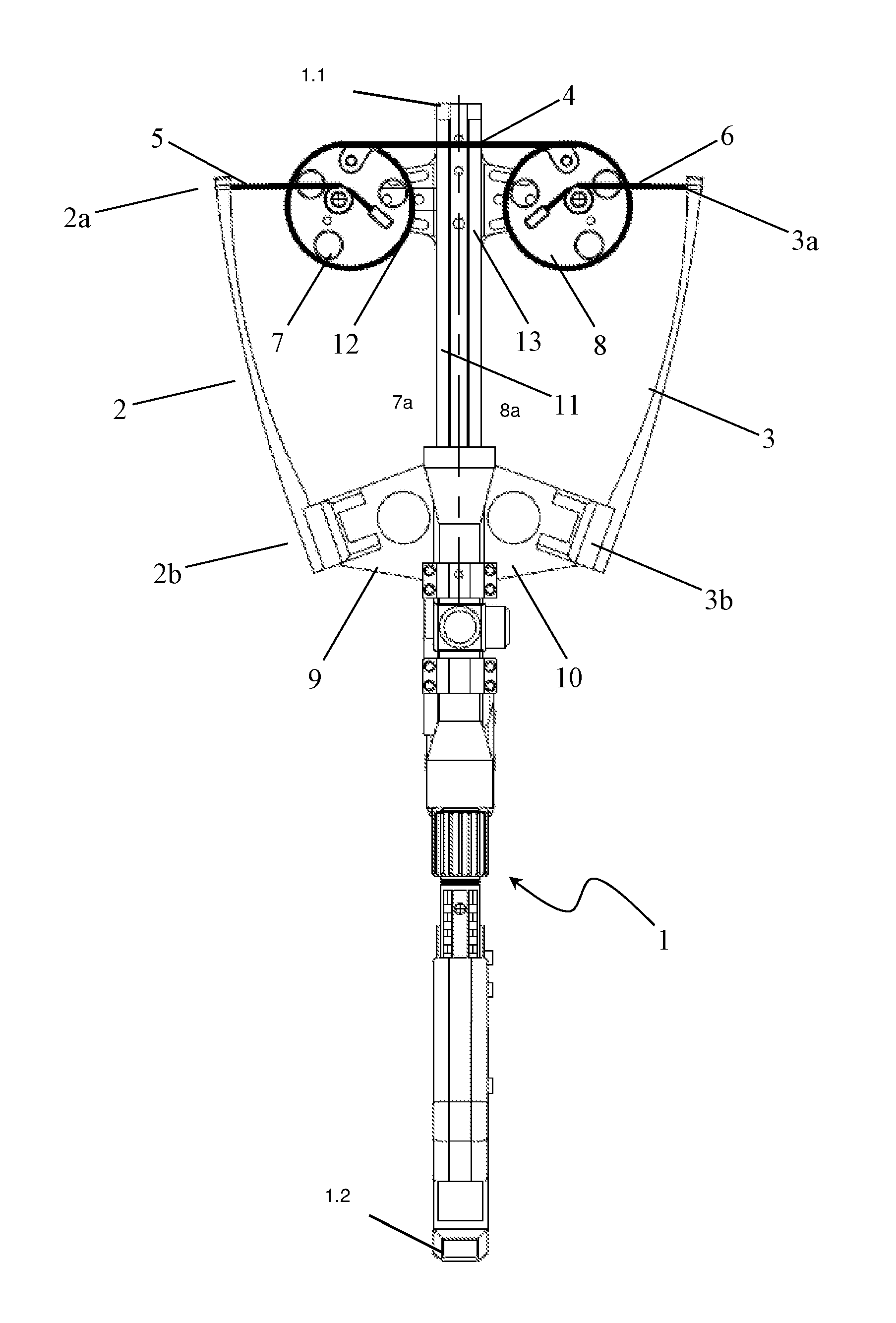
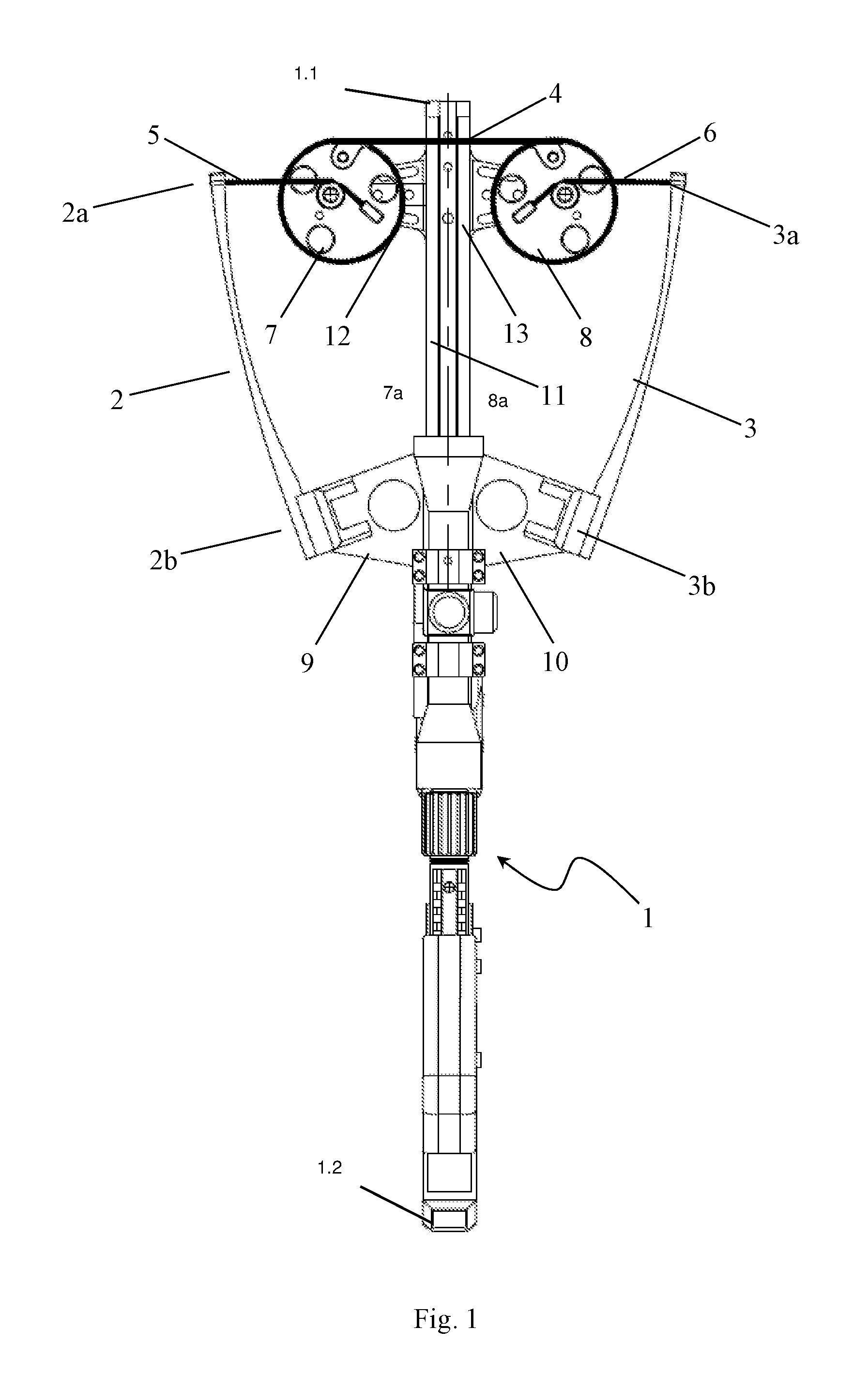






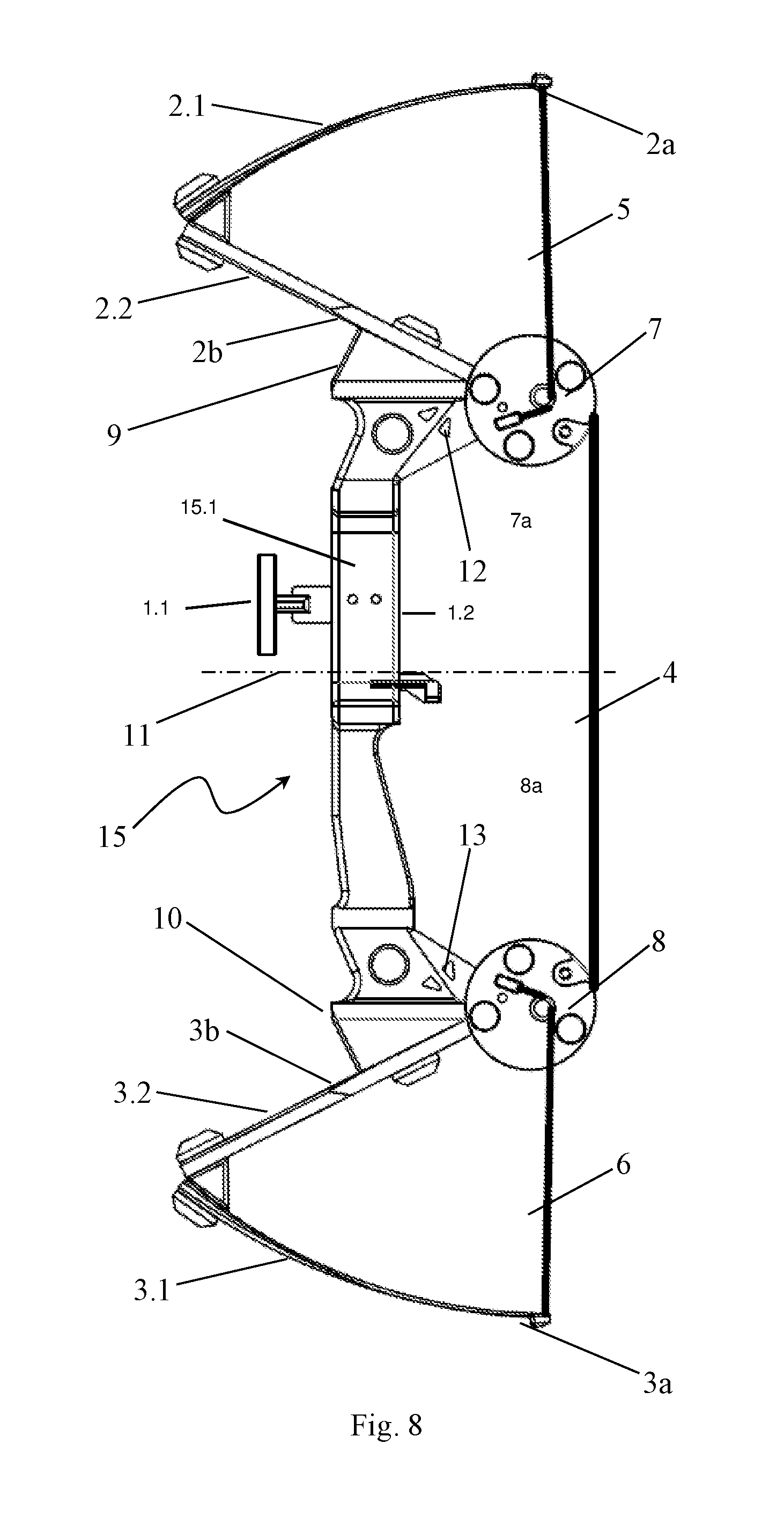
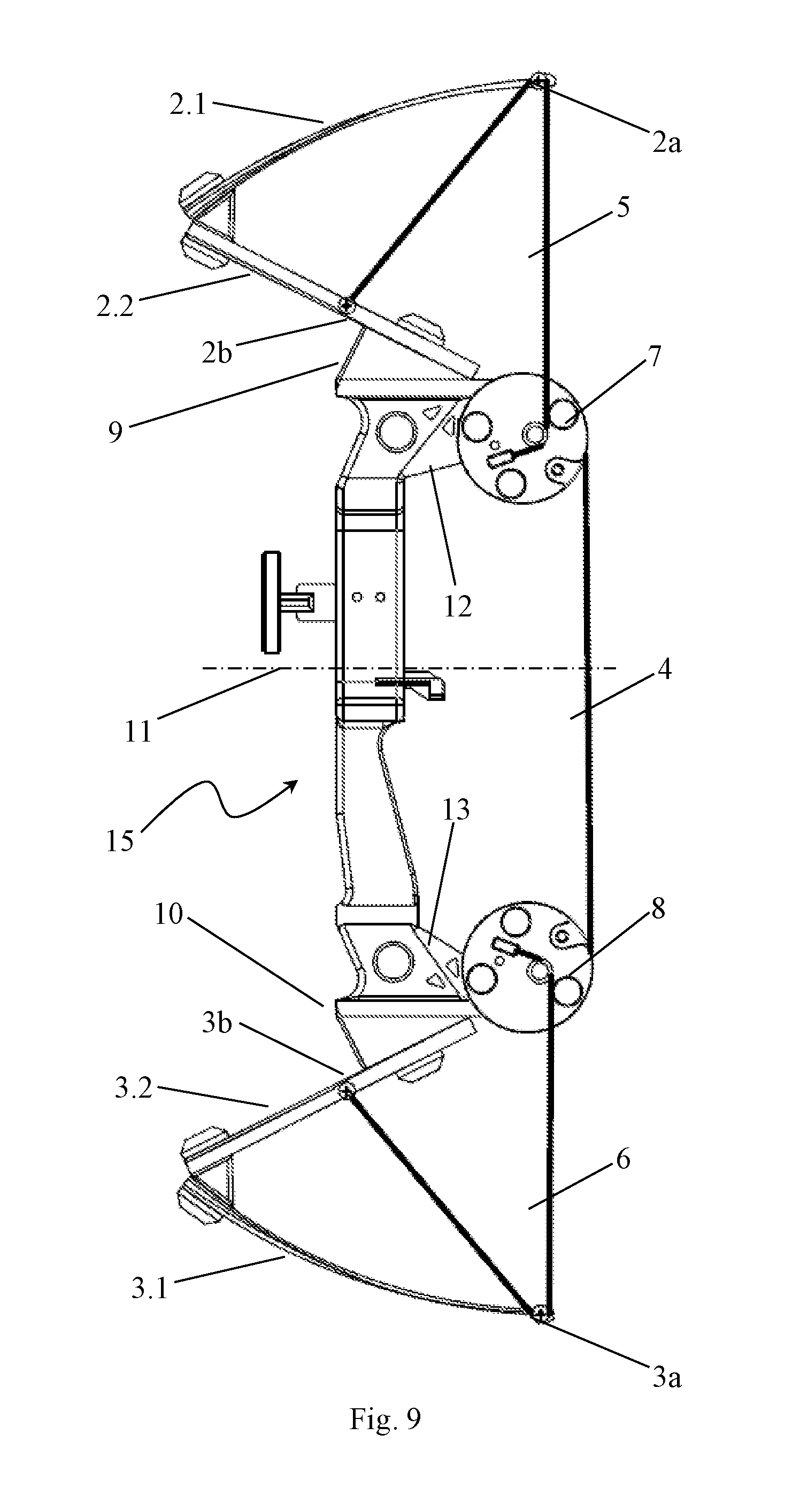
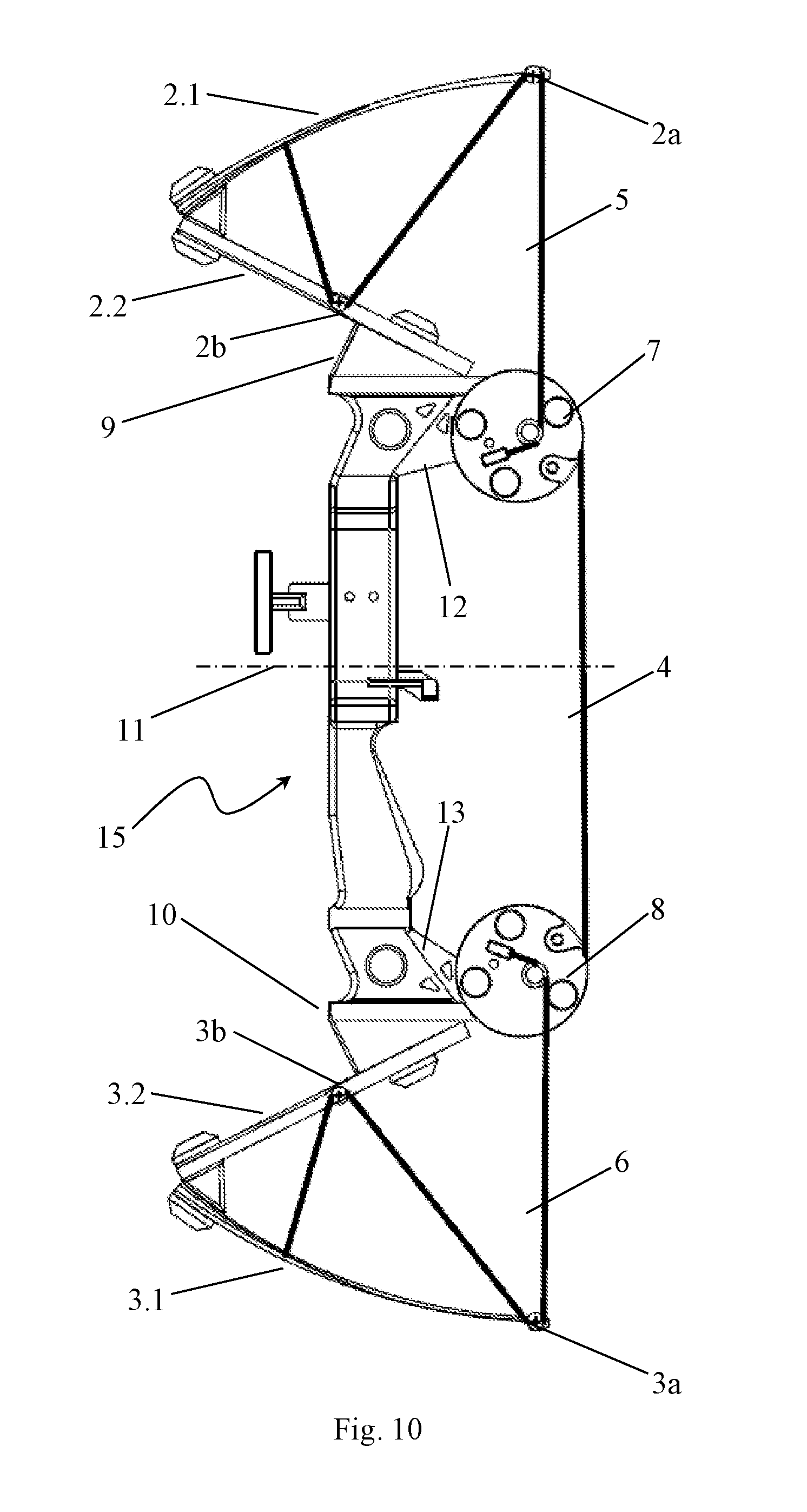
| United States Patent | 10,393,470 |
| Popov , et al. | August 27, 2019 |
Super compact archery bow technology
Abstract
The crossbow includes a frame, a first limb and a second limb connected to the frame, a first cam and a second cam mounted on opposite sides of an axis of arrow travel, a string connecting the first cam and the second cam, a first cable connecting the first cam and the first limb, and a second cable connecting the second cam and the second limb. The first cam and the second cam are mounted on a holder of the first cam and a holder of the second cam. The first cam is arranged entirely between the axis of arrow travel and a loose end of the first limb. The second cam is arranged entirely between the axis of arrow travel and a loose end of the second limb. The crossbow reduces overall dimensions of an arrow throwing device while maintaining arrow speed by changing a traditional position of cams.
| Inventors: | Popov; Sergey (Moscow, RU), Ivanov; Pavel (Moscow, RU) | ||||||||||
|---|---|---|---|---|---|---|---|---|---|---|---|
| Applicant: |
|
||||||||||
| Assignee: | Popov; Sergey (Moscow,
RU) |
||||||||||
| Family ID: | 67700711 | ||||||||||
| Appl. No.: | 15/965,482 | ||||||||||
| Filed: | April 27, 2018 |
| Current U.S. Class: | 1/1 |
| Current CPC Class: | F41B 5/105 (20130101); F41B 5/10 (20130101); F41B 5/0094 (20130101); F41B 5/123 (20130101); F41B 5/1469 (20130101) |
| Current International Class: | F41B 5/12 (20060101); F41B 5/10 (20060101) |
References Cited [Referenced By]
U.S. Patent Documents
| 3987777 | October 1976 | Darlington |
| 4077385 | March 1978 | Fredrickson |
| 4461267 | July 1984 | Simonds |
| 6776148 | August 2004 | Islas |
| 7578289 | August 2009 | Norkus |
| 7823572 | November 2010 | Anderson |
| 7891348 | February 2011 | Colley |
| 8651095 | February 2014 | Islas |
| 9297604 | March 2016 | Sidebottom |
| 9354015 | May 2016 | Yehle |
Attorney, Agent or Firm: Craft Chu PLLC Chu; Andrew W.
Claims
We claim:
1. A crossbow, comprising: a frame with an axis of arrow travel extending along said frame; a first limb being connected to said frame and being comprised of at least one first loose end; a second limb being connected to said frame and being comprised of at least one second loose end; a first cam mounted on a first side of said frame; a second cam mounted on a second side of said frame, said first side being opposite said second side along said axis of arrow travel; a first holder between said first cam and said frame, said first cam being mounted on said first holder; a second holder between said second cam and said frame, said second cam being mounted on said second holder; a string connected to said first cam and said second cam, said string having a free state and a drawn state; at least one first cable connected to said first cam and said at least one first loose end; and at least one second cable connected to said second cam and said at least one second loose end, wherein the first cam is arranged entirely between the axis of arrow travel and said at least one first loose end, when said string is in said free state, wherein the second cam is arranged entirely between the axis of arrow travel and said at least one second loose end, when said string is in said free state, wherein said at least one first cable is arranged entirely on said first side, and wherein said at least one second cable is arranged entirely on said second side.
2. The crossbow of claim 1, wherein said first limb is comprised of a plurality of first limb portions, and wherein said second limb is comprised of a plurality of second limb portions.
3. The crossbow of claim 1, wherein said first holder is fixed when said string is in said drawn state, and wherein said second holder is fixed when said string is in said drawn state.
4. The crossbow of claim 1, wherein said first holder is movable when said string is in said drawn state, and wherein said second holder is movable when said string is in said drawn state.
5. The crossbow of claim 1, wherein said first holder is made integral with said frame, and wherein said second holder is made integral with said frame.
6. The crossbow of claim 1, wherein said first holder is removably attached to said frame, and wherein said second holder is removably attached to said frame.
7. A bow, comprising: a handle having a midpoint and an axis of arrow travel extending through said midpoint and transverse to said handle; a first limb being connected to said handle and being comprised of at least one first loose end; a second limb being connected to said handle and being comprised of at least one second loose end; a first cam mounted on a first side of said handle; a second cam mounted on a second side of said handle, said first side being opposite said second side at said midpoint of said handle along said axis of arrow travel; a first holder with said first cam mounted on said first holder; a second holder with said second cam being mounted on said second holder; a string connected to said first cam and said second cam, said string having a free state and a drawn state; at least one first cable connected to said first cam and said at least one first loose end; and at least one second cable connected to said second cam and said at least one second loose end, wherein the first cam is arranged entirely between the axis of arrow travel and said at least one first loose end, when said string is in said free state, wherein the second cam is arranged entirely between the axis of arrow travel and said at least one second loose end, when said string is in said free state, wherein said at least one first cable is arranged entirely on said first side, and wherein said at least one second cable is arranged entirely on said second side.
8. The bow of claim 7, wherein said first limb is comprised of a plurality of first limb portions, and wherein said second limb is comprised of a plurality of second limb portions.
9. The bow of claim 7, wherein said first holder is fixed when said string is in said drawn state, and wherein said second holder is fixed when said string is in said drawn state.
10. The bow of claim 7, wherein said first holder is movable when said string is in said drawn state, and wherein said second holder is movable when said string is in said drawn state.
11. The bow of claim 7, wherein said first holder is made integral with said handle, and wherein said second holder is made integral with said handle.
12. The bow of claim 7, wherein said first holder is removably attached to said handle, and wherein said second holder is removably attached to said handle.
Description
CROSS-REFERENCE TO RELATED APPLICATIONS
See Application Data Sheet.
STATEMENT REGARDING FEDERALLY SPONSORED RESEARCH OR DEVELOPMENT
Not applicable.
THE NAMES OF PARTIES TO A JOINT RESEARCH AGREEMENT
Not applicable.
INCORPORATION-BY-REFERENCE OF MATERIAL SUBMITTED ON A COMPACT DISC OR AS A TEXT FILE VIA THE OFFICE ELECTRONIC FILING SYSTEM (EFS-WEB)
Not applicable.
STATEMENT REGARDING PRIOR DISCLOSURES BY THE INVENTOR OR A JOINT INVENTOR
Not applicable.
BACKGROUND OF THE INVENTION
1. Field of the Invention
The present invention relates to devices for throwing arrows, in particular, to bows and crossbows.
2. Description of Related Art Including Information Disclosed Under 37 CFR 1.97 and 37 CFR 1.98
Arrow throwing devices are known, such as bows and crossbows. For instance, U.S. Pat. No. 8,651,095 discloses the crossbow comprising the frame, the first limb and the second limb mounted on the frame so that one end of each limb is secured to the frame, and another end of each limb is the loose end. The first cam and the second cam are mounted at the loose ends of the first limb and the second limb, respectively. The first cam and the second cam are connected with the string. In addition, the first cable and the second cable are attached to the first cam and the second cam, respectively, and the other ends of the cables are connected to the projections provided on the frame. Due to the use of cams and cables, the firing speed can be increased. However, such arrangement of the first cam and the second cam at the respective loose ends of the limbs causes the increase in crossbow dimensions, because portions of the cams project beyond the bow dimensions defined by the limbs. This makes usage and transportation of the known crossbow difficult.
U.S. Pat. No. 7,047,958 discloses the bow having a complex system of cams and spools forming the integral complex system. In this device, like in the above crossbow, the elements of the complex system are arranged at the loose ends of the limbs, thus increasing bow dimensions and making usage and transportation thereof quite difficult.
It is also known the bow disclosed in U.S. Pat. No. 4,287,867, wherein the cams are used which actually work as pulleys, or spools, connecting middle portions of the limbs with one of the loose ends of the limbs. The configuration of this known device needs be more sophisticated, as shown in this patent, and requires somewhat longer limbs to provide a high arrow speed. Consequently, it looks impossible to reduce overall dimensions by exclusion of the elements affecting tension of the string because the limbs must be longer to keep arrow speed high.
Therefore, there is the need to reduce overall dimensions of the arrow throwing device while maintaining essential technical characteristics thereof, such as the firing speed of an arrow.
BRIEF SUMMARY OF THE INVENTION
The present invention addresses the mentioned above problem of reduction of overall dimensions of an arrow throwing device while maintaining a high arrow speed by changing a traditional position of cams. In particular, instead of arranging the cams at loose ends of limbs it is suggested to mount the cams within an area defined by an axis of arrow travel and a corresponding loose end of the limb. In a crossbow, the axis of arrow travel extends approximately along a crossbow frame, and in a bow, it extends approximately transversely to a middle portion of a bow handle.
The cams can be arranged both directly on the crossbow frame or the bow handle and on appropriate holders, wherein the holders can be made fixed (i.e., rigid), as well as movable (or flexible).
A string at least partially wraps each of the cams.
Both the crossbow and the bow are fitted with cables connecting each cam with at least one of the loose ends of the corresponding limb.
Advantages of the crossbow and the bow according to the present invention will be described below in details with references to drawings illustrating exemplary embodiments of the present invention which is, however, not limited by the described embodiments.
BRIEF DESCRIPTION OF THE SEVERAL VIEWS OF THE DRAWINGS
FIGS. 1-7 show top plan views of embodiments of a crossbow in accordance with the present invention.
FIGS. 8-10 show side elevation views of embodiments of a bow in accordance with the present invention.
DETAILED DESCRIPTION OF THE INVENTION
FIGS. 1-7 show various embodiments of a crossbow in accordance with the present invention.
In general, the crossbow comprises a frame 1 with a front side 1.1 and a back side 1.2, a first limb 2 and a second limb 3, a string 4, at least one first cable 5 and at least one second cable 6, and a first cam 7 and a second cam 8.
The first limb 2 has two ends 2a, 2b. The first end or first loose end 2a of the first limb is a loose end, and the second end 2b of the first limb can be either a secured end (FIGS. 1-6) or a loose end (FIG. 7). Similarly, the second limb 3 has two ends 3a, 3b. The first end or second loose end 3a of the second limb is a loose end, and the second end 3b of the second limb can be either a fixed end (FIGS. 1-6) or a loose end (FIG. 7). The fixed ends 2b, 3b can be attached directly to the frame 1, as shown in FIGS. 2, 3, or it can be attached to the frame 1 via corresponding holders 9, 10 (FIGS. 1, 4-6). If the ends 2b, 3b are the loose ends, the limbs 2, 3 can be attached at middle portions thereof to the frame via the limb holders 9, 10, respectively (FIG. 7).
The first limb 2 and the second limb 3 can comprise either one portion (FIGS. 1, 4-7), or more than one portion, e.g. two portions 2.1, 2.2 and 3.1, 3.2, respectively, as shown in FIGS. 2, 3.
The loose ends of the limbs 2, 3 can be oriented both in an arrow travel direction (FIGS. 1, 3-6), and in a backward direction of arrow travel (FIG. 2).
The limb holders 9, 10 can be made as separate members which are attached from both sides of the frame 1, or can be a part of the frame 1, or can be one integral member (also known as "a riser") which is attached to the frame 1.
Extended substantially along the frame 1 is an axis 11 of arrow travel along which the arrow (not shown in Figures) is placed when loading into the crossbow and travels on firing.
The first cam 7 and the second cam 8 are mounted on opposite sides, a first side 7a for the first cam 7 and a second side 8a for the second cam 8, of the frame 1 and the axis 11 of arrow travel, respectively. The first cam 7 and the second cam 8 are attached to the frame 1 via a cam holder 12 of the first cam and a cam holder 13 of the second cam. The cam holders 12, 13, a first cam holder 12 and a second cam holder 13, can be both individual separate members or one integral member, and a part of the frame 1, i.e., they can be made integral to the frame 1.
If the cam holders 12, 13 are individual members, they can be made rigid (maintaining the shape and/or dimensions in normal use of the crossbow), i.e. fixed.
Alternatively, the cam holders 12, 13 can be made movable. For instance, the cam holders 12, 13 can be made of a resilient material. Another possible variant includes a movable attachment of the cam holders 12, 13 to the frame 1.
The first cam 7 is arranged so that when at least the first end 2a is at least in a free state (i.e., when the crossbow is not in a drawn state), the first cam 7 is located entirely between the axis 11 of arrow travel and the first end 2a. However, when the crossbow is in the drawn state, it may be preferable to have the cam 7 partially projected beyond the overall dimensions of the limb 2. It is further preferable, in case of the crossbow with the limb 2 having two loose ends as shown in FIG. 7, to have the cam 7 entirely between the axis 11 of arrow travel and the ends 2a, 2b, at least when the crossbow is not in the drawn state.
Similarly, the second cam 8 is arranged so that when at least the first end 3a is at least in a free state (i.e. when the crossbow is not in the drawn state), the second cam 8 is located entirely between the axis 11 of arrow travel and the first end 3a. However, when the crossbow is in the drawn state, it may be preferable to have the cam 8 partially projected beyond the overall dimensions of the limb 3. It is further preferable, in case of the crossbow with the limb 3 having two loose ends as shown in FIG. 7, to have the cam 8 entirely between the axis 11 of arrow travel and the ends 3a, 3b, at least when the crossbow is not in the drawn state.
The cams 7, 8 can be any cams well-known to one of ordinary skill in the art.
The string 4 connects the cams 7, 8 and supplies an initial arrow speed. The cables 5, 6 connect the cams 7, 8 to the first ends 2a, 3a, respectively, as shown in FIGS. 1-6, or to the first and second ends 2a, 2b and 3a, 3b, respectively, as shown in FIG. 7.
The cables 5, 6 can be attached to the first ends 2a, 3a (e.g. as shown in FIGS. 1-3). The cables 5, 6 can extend through the first ends 2a, 3a and be attached to the frame 1 (FIG. 4), or to the limb holders 9, 10 (FIG. 5), or to a foot stirrup 14 (FIG. 6). The cables 5, 6 also can extend through the first ends 2a, 3a and be attached to the second ends 2b, 3b (FIG. 7).
FIGS. 1-7 do not represent all possible embodiments of the crossbow in accordance with the present invention. One of ordinary skill in the art would appreciate all other possible embodiments of the crossbow.
When pulling the string 4 back, the cams 7, 8 start rotating about their axes of rotation (not shown in Figures). The cables 7, 8 are wrapped around the cams 7, 8, thus making the first limb 2 and the second limb 3, respectively, bended. The more rigid the limbs 2, 3 are and the more the limbs 2, 3 bend, the higher the initial arrow speed is.
It is preferable to have the first cable 5 entirely arranged on the same side from the axis 11 of arrow travel as the corresponding first cam 7. Similarly, it is preferable to have the second cable 6 entirely arranged on the same side from the axis 11 of arrow travel as the corresponding second cam 8. In this case, the cables 5, 6 will not intersect the axis 11 of arrow travel, i.e., not interfere with the path of arrow loading and not intersect the arrow travel.
FIGS. 8-10 show embodiments of a bow in accordance with the present invention.
In general, the bow comprises a handle 15 having a midpoint 15.1 with a front side 1.1 and a back side 1.2, a first limb and second limb, a string 4, at least one first cable 5 and at least one second cable 6, and a first cam 7 and a second cam 8.
In the possible embodiments of the bow in accordance with the present invention shown in FIGS. 8-10, the first limb consists of two portions 2.1 and 2.2, and the second limb consists of two portions 3.1 and 3.2. One skilled in the art would appreciate however that the first limb and the second limb each can be a one element if the portions 2.1 and 2.2 are made as a one-piece and the portions 3.1 and 3.2 are made as a one-piece, too.
The first limb has two ends 2a, 2b. The first end or first loose end 2a of the first limb is the loose end, and the second end 2b of the first limb is the fixed end. Similarly, the second limb has ends 3a, 3b. The first end or second loosed end 3a of the second limb is the loose end, and the second end 3b of the second limb is fixed. The fixed ends 2b, 3b can be attached directly to the handle 15 or, as shown in FIGS. 8-10, can be attached to the handle 15 via the corresponding holders 9, 10.
Extended substantially transversely to the handle 15 approximately in the middle portion thereof is an axis 11 of arrow travel along which an arrow (not shown in Figures) is arranged when loading into the bow and travels on firing.
The first cam 7 and the second cam 8 are mounted on opposite sides of the handle 15 and the axis 11 of arrow travel, respectively. The first cam 7 and the second cam 8 are attached to the handle 15 via a cam holder 12 of the first cam and a cam holder 13 of the second cam. The cam holders 12, 13 can be individual separate members or one integral member, and can be a part of the handle 15, i.e., they can be made integral to the handle 15.
If the cam holders 12, 13 are individual members, they can be made rigid (maintaining the shape and/or dimensions thereof in normal use of the bow), i.e. fixed.
Alternatively, the cam holders 12, 13 can be made movable. For instance, the cam holders 12, 13 can be made of a resilient material. Another possible variant includes a movable attachment of the cam holders 12, 13 to the handle 15.
The first cam 7 is arranged so that when at least the first end 2a is at least in a free state (i.e. when the bow is not in a drawn state), the first cam 7 is located entirely between the axis 11 of arrow travel and the first end 2a. Similarly, the second cam 8 is arranged so that when at least the first end 3a is at least in the free state (i.e. when the bow is not in the drawn state), the second cam 8 is located entirely between the axis 11 of arrow travel and the first end 3a.
The cams 7, 8 can be any cams well-known to one of ordinary skill in the art.
The string 4 connects the cams 7, 8 and supplies an initial arrow speed. The cables 5, 6 connect the cams 7, 8, respectively, to the first ends 2a, 3a.
The cables 5, 6 can be attached to the first ends 2a, 3a, as shown in FIG. 8. The cables 5, 6 can extend through the first ends 2a, 3a and be attached to the second portions of the limbs 2b, 3b, as shown in FIG. 9. The cables 5, 6 can extend through the first ends 2a, 3a, further through the second portions of the second portions of the limbs 2b, 3b and be attached to the first portions of the limbs 2a, 3a, as shown in FIG. 10. The one skilled in the art would appreciate other possible embodiments of the attachment of the ends of the cables 5, 6 that are not shown in Figures, such as on the limb holders 9, 10.
FIGS. 8-10 do not represent all possible embodiments of the bow in accordance with the present invention. One of ordinary skill in the art would appreciate all other possible embodiments of the bow.
When pulling the string 4 back, the cams 7, 8 start rotating about their axes of rotation (not shown in Figures). The cables 7, 8 are wrapped around the cams 7, 8, thus bending the first limb and the second limb, respectively. The more rigid the first limb and the second limb are and the more these limbs bend, the higher the initial arrow speed is.
It is preferable to have the first cable 5 entirely arranged on the same side from the axis 11 of arrow travel as the corresponding first cam 7. Similarly, it is preferable to have the second cable 6 entirely arranged on the same side from the axis 11 of arrow travel as the corresponding second cam 8. In this case, the cables 5, 6 will not intersect the axis 11 of arrow travel, i.e., not interfere with the path of arrow loading and not intersect the arrow travel.
In addition to the indicated above decrease of the overall dimensions while maintaining the firing speed, further advantages of the claimed arrow throwing devices over the known crossbows and bows are worth mentioning.
Firstly, placing the cams closer to the axis of arrow travel and, therefore, to the area which is hand-held by a user during the use of an arrow throwing device allows to reduce the torque developed by said device. This contributes to the more stable holding of the crossbow or bow resulting in lower arm loading, in particular, a user hand loading.
Secondly, since the cams are now displaced from the loose ends of the limbs, the load applied to these loose ends of the limbs is reduced. To attach the cam to the loose end of the limb, as used in the known devices, a tip of the loose end of the limb has to be provided with openings and/or cutouts, and therefore the loose end of the limb has to be reinforced. In addition, during the use of the known devices the cams can slightly shift with respect to attachment axes thereof, thus leading to additional rotational loads applied to the loose ends of the limb. If the cams are not located at the loose ends of the limbs like in the present invention, there is no need to reinforce the loose ends.
Thus, the present invention provides significant advantages over the known crossbows and bows and yet has no impact on one of the main characteristics, namely, the initial speed of arrow flight.
* * * * *
D00000

D00001

D00002

D00003

D00004

D00005

D00006

D00007

D00008

D00009

D00010

XML
uspto.report is an independent third-party trademark research tool that is not affiliated, endorsed, or sponsored by the United States Patent and Trademark Office (USPTO) or any other governmental organization. The information provided by uspto.report is based on publicly available data at the time of writing and is intended for informational purposes only.
While we strive to provide accurate and up-to-date information, we do not guarantee the accuracy, completeness, reliability, or suitability of the information displayed on this site. The use of this site is at your own risk. Any reliance you place on such information is therefore strictly at your own risk.
All official trademark data, including owner information, should be verified by visiting the official USPTO website at www.uspto.gov. This site is not intended to replace professional legal advice and should not be used as a substitute for consulting with a legal professional who is knowledgeable about trademark law.